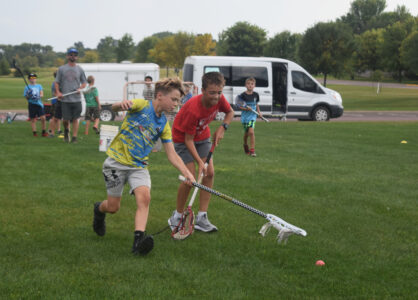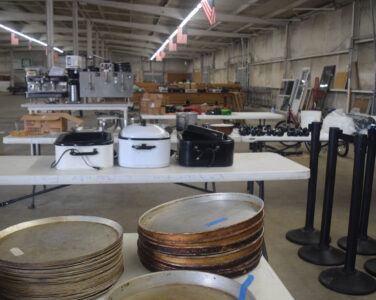Lakes group dives into harvesting, chemicals to combat CLP
FAIRMONT– The city of Fairmont’s newly formed Lakes Management Committee had its fourth official meeting on Wednesday. The group revisited some topics including harvesting and/or chemical treatment for Curly Leaf Pondweed (CLP) and also talked about funding sources for projects.
Courtney Phillips, a program and project coordinator with the Shell Rock Watershed District spoke about different funding options for large scale projects, such as rock arch rapids, which was discussed at the last meeting as a possible replacement of the George Lake Dam.
Phillips shared that she’s based out of Albert Lea and that they have a tax levy that’s relatively small, about $500,000, which is their only guaranteed income. She said for their projects they’ve been aggressive in applying for different grants and have tapped into Lessard Sams Outdoor Heritage Council funding.
“I’ve been at the district for 10 years. I’d say we’ve received about $15 to $20 million for projects,” Phillips said.
She spoke about some of the projects they’ve done including fish barriers and rock arch rapids and dam replacement, which they received about $2.4 million for.
“Instead of just applying for one project… we would apply for anywhere between $4 to $6 million worth of projects a year. We roughly get about $1 to $2 million back,” Phillips said.
While they’ve picked bigger projects to tackle, she said they’ll also do about $100,000 worth of wetland restoration from time to time, too.
As for how to apply for the funds, Phillips said they don’t necessarily use an engineer to come up with an estimate as they usually have a good idea of what a project is going to cost.
“A lot of these are reimbursement-style grants so you need to keep that in mind,” Phillips shared.
Fairmont’s Water Resources Coordinator, Hannah Neusch, noted that Fairmont has received Lessard Sams funds in the past for the Dutch Creek Habitat Project and that the city had internally applied for it.
Jon Omvig, chairman of the Fairmont Lakes Foundation, Inc. (FLF), asked Phillips if they have a lakes management plan that has identified the different projects and what their priorities are.
Phillips said they have a comprehensive watershed management plan, that comes with funding, that helps guide them.
“We’re very lake-heavy like you guys are. A lot of our projects are focused on upstream, water storage, that kind of stuff,” Phillips said.
Omvig also asked how the Shell Rock Watershed District was formed and Phillips shared that it was born out of a citizen petition to dredge the lakes.
“We’ve completed two phases and we have the funding for the third, we’re just waiting from the DNR for permitting,” Phillips said.
In addition, she said they also went through the legislative process to get a local option sales tax, a half-cent sales tax within the city of Albert Lea. The money goes to the city council, which then appropriates it to the watershed district.
“The language is that it’s for projects identified in our watershed plan, the comprehensive One Watershed, One Plan,” Phillips said. “A lot of that went to the dredging project. So far we’ve probably spent $15 million in dredging, $9 million of that has been in state bonding.”
The group once again talked about CLP and the potential of putting together a Request for Proposal (RFP) for harvesting CLP.
Neusch said she hasn’t heard much from citizens about CLP as it’s become less visible at the end of summer. However it remains a concern and a priority and the city is looking toward the future.
Community Development Director, Pat Oman, gave a recap of this past summer and said that a lot of residents and lake property owners wanted to see something done with CLP so the city contracted with a permitted vendor who could remove CLP and pick it up from both driveways and docks. In the first year, the program was successful with more than 14,000 tons collected.
Oman also spoke abut a recent presentation from Dr. Ryan Wersal, an aquatic weed specialist, who spoke about the need to address CLP from a few different directions.
“Dr. Wersal mentioned, harvesting is not going to be cost effective to try to harvest all of the lakes. We’re just not going to have enough money, but he said we could do targeted harvesting whether it’s boat landings, beach swimming areas, intake areas,” Oman said. “That is something we could generate an RFP (for).”
Oman mentioned that lake herbicide has also been mentioned for use to address CLP.
“This to me would be the next logical step for the city council to consider,” Oman said.
Neusch asked Phillips what they do to address CLP and Phillips shared that following the dredging process, they had a lot of CLP and while they looked at a few options, they decided not to do harvesting and instead used a chemical product to treat it.
“It worked very, very well. We did apply for funding. The DNR does have funding to spray Curly Leaf Pondweed. They do have some stipulations,” Phillips said.
Neuch said Fairmont had applied, but that CLP was not a priority species for treatment so the city did not get any money.
Phillips admitted that they did not end up getting any funds from the DNR either, but said, “It was such an issue for us and it came on so fast and so heavy that we just decided to fund it.”
Jesse Walter with SWCD told Phillips that one of Fairmont’s complications is that it pulls drinking water from the lakes.
Neusch added, “In order for us to apply a chemical to the lakes, we would have to get approval from not only the appropriate authorities like the DNR, but the Department of Health, which is understandable. We’re in the process of figuring out how that all works but it’s not as simple as just a recreational lake.”
Oman again said from what Wersal shared, any chemical treatment should be coupled with harvesting.
After some discussion about tapping into well water in the event that chemical product is put into the lakes, Omvig posed a thought. He said from what he believes, CLP is at its height from mid June to mid July.
“If you’re going to do harvest, try it as Ryan (Wersal) said, target an area, and do contracts for 30 to 40 days, intensive, over and over harvesting,” Omvig said.
City Council Member Britney Kawecki said the committee has gathered for a few meetings now and acknowledges that CLP needs to be addressed by several methods, yet only harvesting has been seriously talked about.
She expressed concern that citizens will soon start applying their own chemicals at their properties to address CLP.
Per state law, private citizens are only supposed to use approved chemicals with a permit from the DNR.
“People are going to take it into their own hands,” Kawecki said. “If you think by not using chemicals and you’re just going to harvest… that the citizens of Fairmont are going to be okay with this when you’re increasing their utility bill (for lake restoration fund) by $3 and you’re taking in another $230,000 a year and they’re not seeing anything, because you support harvesting. They’re going to take it into their own hands.”
Oman pointed out that the Lakes Management Committee doesn’t decide anything, only discusses, but that the city council can make decisions. He said that no options, including chemical treatment, are being ignored.
“We are on a timeline for permitting and that hasn’t changed so I think we’re moving on all fronts,” Oman said.
In other business at the meeting:
— The group heard from Ben Lundeen, a statewide monitoring coordinator with the Minnesota Pollution Control Agency (MPCA) who spoke about section 319 small watershed focus and CD 28.
— Neusch went over a Wakeboat Lakebed Impact Study done by the University of Minnesota.
— Omvig said FLF is in contact with Hand’s Fish Seining and some other similar companies about invasive carp management.
— Walters spoke about some of SWCD’s project proposals, which will soon come before the city council.
— Neusch talked about the DNR’s proposal to raise the yellow bass limit from 30 to 100.


